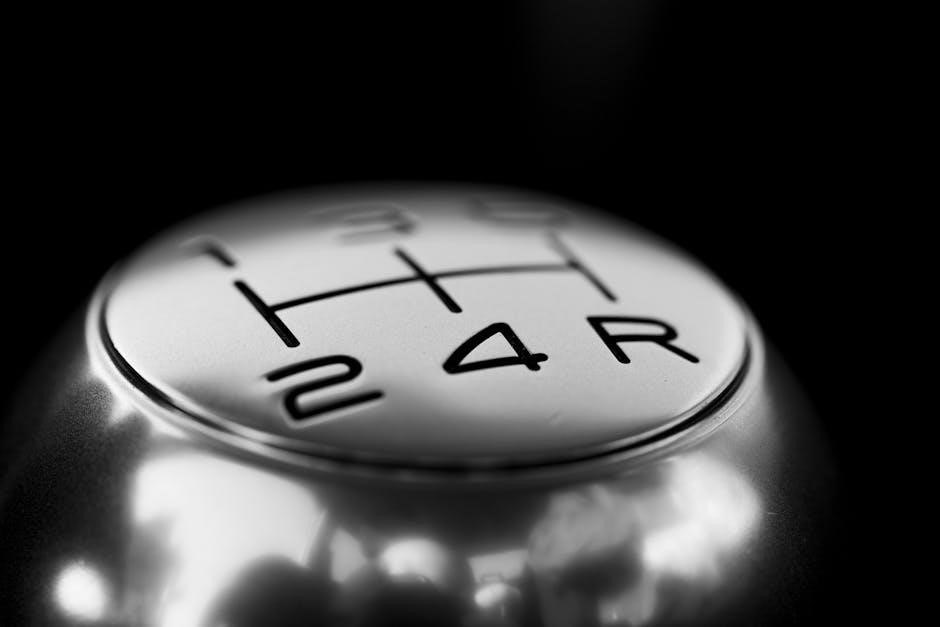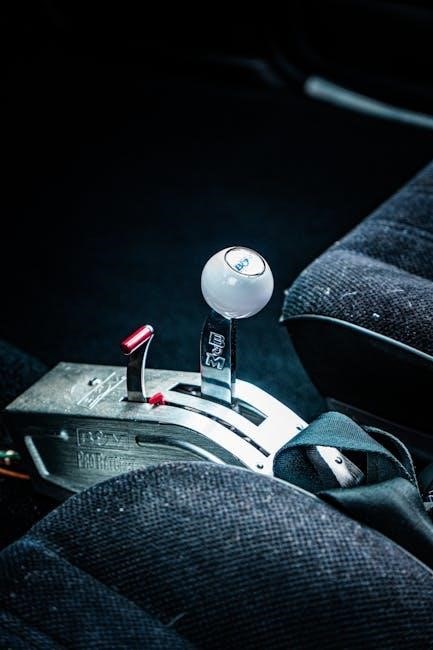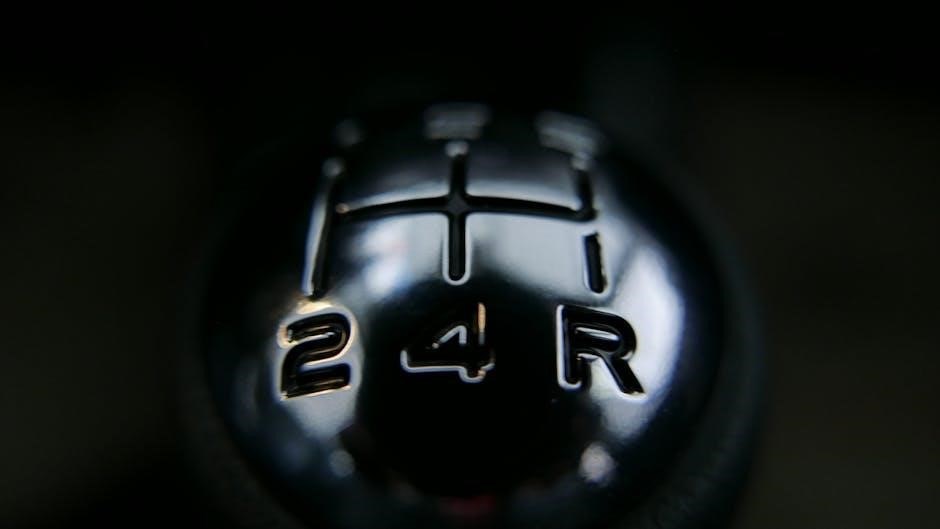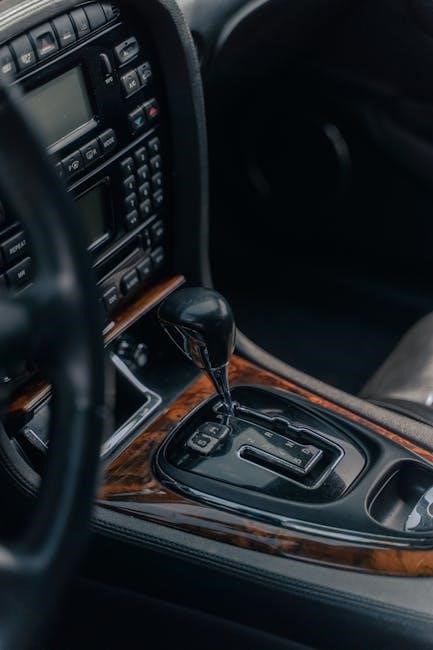Converting a manual gearbox to an automatic transmission involves complex modifications, requiring mechanical expertise and specialized components. This process offers benefits like smoother performance and convenience but demands significant investment.
Overview of the Conversion Process
Converting a manual gearbox to an automatic transmission involves replacing the manual gearbox with a compatible automatic unit. This requires installing the new transmission, adapting drivetrain components, and integrating electrical systems. Key steps include removing the manual gearbox, fitting the automatic transmission, and ensuring all components work seamlessly. Recalibrating the speedometer is essential due to altered gear ratios. Regular maintenance post-conversion ensures optimal performance and longevity. This process demands precision and expertise to achieve a smooth, functional result.
Importance of Understanding the Differences Between Manual and Automatic Transmissions
Understanding the distinctions between manual and automatic transmissions is crucial for a successful conversion. Manual transmissions rely on driver input for gear shifts, using a clutch and gearstick, while automatics use a torque converter and hydraulic system for seamless shifting. These differences affect components like drivetrain, electrical systems, and clutch mechanisms. Recognizing these variations ensures compatibility and proper installation during the conversion, preventing potential issues such as incorrect gear ratios or system malfunctions.

Understanding Manual and Automatic Transmissions
Manual transmissions rely on driver input for gear shifts, using a clutch and gearstick, while automatics employ a torque converter and hydraulic system for seamless operation.
Key Components of a Manual Transmission
A manual transmission consists of key components like the clutch, gearstick, and synchromesh. The clutch disconnects the engine from the gearbox, allowing gear changes. The gearstick selects gears manually, while synchromesh ensures smooth shifting between gears. Other critical parts include the flywheel, pressure plate, and gear sets. These components work together to provide driver control over acceleration and speed, making manual transmissions popular for their precision and fuel efficiency. Understanding these elements is essential for any gearbox conversion process.
Key Components of an Automatic Transmission
An automatic transmission relies on a torque converter to transfer power from the engine, eliminating the need for a manual clutch. It features planetary gear sets, which provide multiple gear ratios, and hydraulic systems to engage and disengage these gears. Additional components include clutches, bands, and sensors to regulate shifting; These parts work together to deliver seamless, driver-free gear changes, enhancing comfort and convenience. Understanding these components is crucial when planning a manual-to-automatic conversion to ensure compatibility and proper functionality.
Differences in Gear Shifting Mechanisms
Manual transmissions rely on a clutch pedal and gearstick for driver-controlled shifting, offering precise control. Automatic transmissions, however, use a torque converter and hydraulic systems to shift gears automatically. This eliminates manual intervention, providing ease in urban driving. The automatic system employs sensors and hydraulic pressure to engage clutches and bands, determining optimal gear ratios based on speed and throttle input. These fundamental differences in operation and mechanism are key considerations when planning a manual-to-automatic conversion.

Evaluating the Feasibility of a Manual to Auto Conversion
Converting a manual to an automatic transmission is complex and costly, requiring mechanical expertise and compatible components. Assessing feasibility involves evaluating costs, technical challenges, and long-term benefits.
Factors to Consider Before Starting the Conversion
Evaluating feasibility involves assessing costs, compatibility, and technical challenges. Ensure the automatic transmission is compatible with your vehicle’s engine and drivetrain. Consider the financial investment, as conversion kits and labor can be expensive. Mechanical expertise is essential, as the process requires specialized tools and knowledge. Additionally, weigh the benefits of convenience against potential losses in fuel efficiency and performance. Recalibrating systems like the speedometer and integrating electrical components is also critical. Consulting a professional mechanic is highly recommended to avoid costly mistakes.
Cost Implications of the Conversion
The cost of converting a manual to an automatic transmission can be substantial, varying depending on the vehicle and components required. A full conversion kit, including the automatic transmission, torque converter, and adapters, can range from a few thousand to tens of thousands of dollars. Labor costs from a qualified mechanic further increase the expense. Additionally, modifying electrical systems and recalibrating components adds to the financial burden. While the convenience of an automatic transmission is appealing, the high cost may outweigh the benefits for some drivers, making it a significant investment to consider carefully.
Compatibility of Components
Ensuring component compatibility is crucial for a successful manual-to-automatic conversion. The automatic transmission must align with the vehicle’s engine specifications and drivetrain configuration. Adapters and custom mounts may be necessary to fit the new transmission. Additionally, the electrical and hydraulic systems must be compatible with the automatic gearbox, requiring modifications to sensors, wiring, and fluid lines. Incompatibilities can lead to mechanical failures, emphasizing the need for precise component selection and professional installation to achieve seamless integration and optimal performance.

Key Components Required for the Conversion
A successful manual-to-auto conversion requires an automatic transmission, torque converter, adapters, and conversion kits. These components ensure compatibility and proper integration with the vehicle’s existing systems.
Automatic Transmission Compatibility
Ensuring the automatic transmission is compatible with the vehicle’s engine and drivetrain is crucial. The transmission must align with the engine’s power output and torque specifications. Additionally, compatibility with existing mounts, driveshafts, and electrical systems is essential. Selecting the wrong transmission can lead to mechanical issues and poor performance. Compatibility kits and expert consultation are often necessary to guarantee a seamless integration and optimal functionality of the new automatic system.
Role of the Torque Converter
The torque converter is a critical component in automatic transmissions, replacing the manual clutch. It facilitates smooth power transfer between the engine and transmission by using hydraulic fluid to connect and disconnect the engine’s power. This allows the engine to idle without stalling and enables seamless gear shifts. Unlike a manual transmission, the torque converter eliminates the need for manual clutch engagement, providing a more convenient and hands-free driving experience while maintaining performance.
Adapters and Conversion Kits
Adapters and conversion kits are essential for integrating an automatic transmission into a vehicle originally designed for manual operation. These kits include adapter plates, custom mounts, and other hardware to align the engine and transmission properly. They ensure compatibility and maintain optimal performance. Conversion kits simplify the process by providing pre-engineered solutions, reducing the need for custom fabrication. Adapters also address drivetrain misalignment, ensuring smooth power delivery. Consulting a mechanic is crucial to select the right kit for your vehicle, ensuring a seamless and functional conversion process.
The Conversion Process
The conversion involves replacing the manual gearbox with an automatic transmission, adapting the drivetrain, and integrating electrical systems for seamless operation, ensuring compatibility and functionality.
Removing the Manual Gearbox
Removing the manual gearbox is the first step in the conversion process, requiring mechanical expertise and specialized tools. The clutch pedal, gear shifter, and driveshaft must be disconnected. Electrical systems, including sensors and wiring, are also severed from the manual transmission. Proper alignment and support are crucial to avoid damage during removal. This step sets the foundation for installing the automatic transmission, ensuring a smooth transition to the new system. Careful planning and precision are essential to avoid complications later in the conversion process.
Installing the Automatic Transmission
Installing the automatic transmission involves securing it to the engine and chassis, ensuring proper alignment with the torque converter. The torque converter must be correctly attached to the engine’s crankshaft. Mounting brackets and adapters are fitted to accommodate the automatic transmission. Coolant lines, electrical connectors, and hydraulic systems are then connected. Final adjustments ensure smooth operation. Testing the system post-installation is critical to verify proper function and integration with the vehicle’s drivetrain, ensuring reliability and performance.
Adapting the Drivetrain
Adapting the drivetrain for a manual-to-auto conversion requires modifying components to accommodate the automatic transmission; The driveshaft may need shortening or resizing to fit the new transmission’s dimensions. Differential gears might also require recalibration to match the automatic transmission’s gear ratios, ensuring optimal power delivery. Mounts and crossmembers are often repositioned for proper alignment. Additionally, the exhaust system may need rerouting to clear the automatic transmission. These adjustments ensure the drivetrain operates seamlessly with the new transmission, maintaining vehicle stability and performance.
Integrating Electrical Systems
Integrating electrical systems is crucial for a smooth manual-to-auto conversion. The automatic transmission must connect to the vehicle’s ECU, which controls gear shifts and torque converter engagement. Sensors for transmission temperature, gear position, and throttle input are essential for proper functionality. Wiring harnesses may need modification to ensure compatibility with the new transmission. Additionally, the speedometer signal must be recalibrated to reflect accurate readings. In some cases, custom ECU/TCU tuning is required to optimize performance. Proper electrical integration ensures seamless communication between the transmission and the vehicle’s systems.

Post-Conversion Considerations
After converting, ensure proper recalibration of the speedometer and check transmission compatibility with the engine. Regular maintenance and performance checks are vital for optimal functionality.
Recalibrating the Speedometer
After converting to an automatic transmission, recalibrating the speedometer is essential for accurate speed readings. In a manual setup, the speedometer is typically linked to the transmission’s output shaft. However, with an automatic transmission, the altered gear ratios can cause incorrect speedometer readings. This discrepancy must be addressed to ensure proper vehicle operation and compliance with legal standards. A professional mechanic or specialized tools may be required to recalibrate the speedometer effectively, ensuring it aligns with the new transmission’s specifications for precise performance.
Maintenance and Performance Checks
Post-conversion, regular maintenance is crucial to ensure optimal performance. Automatic transmissions rely on fluid levels and torque converter health, requiring periodic checks. The drivetrain must be inspected for alignment and wear, as improper installation can lead to premature damage. Additionally, electrical systems, including sensors and solenoids, should be monitored for proper function. Routine checks help maintain smooth operation and prevent potential issues. Consulting a professional for periodic inspections ensures long-term reliability and performance of the converted transmission system.
Benefits and Drawbacks of the Conversion
Converting to automatic offers convenience and smoother performance but involves high costs and complexity. It simplifies driving in traffic but may reduce fuel efficiency and driver engagement.
Advantages of an Automatic Transmission
An automatic transmission offers unmatched convenience, eliminating the need for manual gear shifting and providing a smoother driving experience. It adapts seamlessly to various driving conditions, ensuring optimal performance and responsiveness. The torque converter acts as a buffer, preventing engine stalling during stops, which is particularly beneficial in heavy traffic. This system enhances comfort, reduces driver fatigue, and simplifies urban commuting. Additionally, automatic transmissions are ideal for drivers who prefer a hands-off approach to gear shifting, making long journeys more enjoyable and less strenuous.
Disadvantages of Converting to Automatic
Converting a manual gearbox to an automatic transmission can be costly and complex, requiring significant mechanical modifications. The process may reduce fuel efficiency due to the torque converter’s energy loss. Additionally, automatic transmissions often weigh more and contain more components, increasing maintenance costs. Compatibility issues with existing drivetrain components can arise, and the conversion may not always enhance performance, especially in vehicles optimized for manual shifting. Furthermore, the upfront investment may not yield proportional benefits, making it less economically viable for some drivers.

Case Studies and Real-World Examples
A notable example is the conversion of a Dodge Viper from manual to automatic, showcasing the complexity and expertise required for such modifications. Real-world applications highlight the feasibility and challenges of achieving seamless performance in modern vehicles.
Successful Manual to Auto Conversions
Several real-world examples demonstrate the success of manual to automatic gearbox conversions. A notable case is the Dodge Viper, originally equipped with a manual transmission, which was successfully converted to an automatic setup by a specialized auto shop. Another example includes classic cars, such as the 1967 Ford F100, where enthusiasts have achieved seamless conversions using compatible automatic transmissions. These projects highlight the feasibility of such conversions when executed with precision and the right components, offering improved convenience and performance for drivers.
Lessons Learned from Previous Conversions
Past conversions reveal critical insights. One key lesson is the importance of compatibility between the automatic transmission and the vehicle’s engine and drivetrain. Another is the necessity of skilled mechanical expertise to avoid costly errors. Additionally, post-conversion maintenance is vital for ensuring longevity and performance. These experiences underscore the complexity of such projects, emphasizing the need for thorough planning and professional guidance to achieve a successful and reliable manual to auto gearbox conversion.
Manual to auto gearbox conversion is a transformative process for car enthusiasts, offering enhanced convenience and performance. It requires mechanical expertise and careful planning to ensure success.
Converting a manual to an automatic transmission involves replacing the manual gearbox with an automatic one, adjusting the clutch pedal, and recalibrating the speedometer. Specialized tools and knowledge are essential for a successful conversion, and consulting a mechanic is advisable. The process can enhance driving convenience but requires careful planning and consideration of costs, maintenance, and legal aspects. Researching conversion kits and understanding the impact on performance and insurance is crucial before proceeding.
Future Trends in Transmission Technology
Future trends in transmission technology include advancements in dual-clutch automatic gearboxes and seamless integration with electric vehicles. Hybrid and fully electric systems are gaining traction, offering improved efficiency. Smart transmissions with adaptive algorithms will optimize gear shifting based on driving habits. Predictive maintenance and over-the-air updates are expected to enhance reliability. These innovations aim to balance performance, convenience, and sustainability, reshaping the automotive landscape for manual-to-automatic conversions and beyond.



